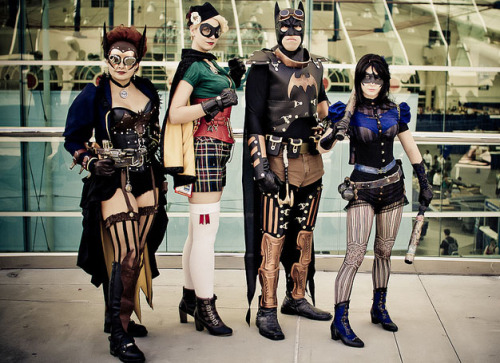
With the increase in the visibility and popularity of cosplay (short for costume play), I thought we could look at an example in the collection to show the long tradition of dress-up in western culture. In the past, people from other cultures, and their dress, were extremely interesting to western culture. These cultures were new to the west, so every aspect of them was examined, usually ending in their commodification. Though the word cosplay wasn't coined until the 1980s, people have been dressing up for hundreds of years. Cosplay, however, has been gaining far more visibility these days due to television shows, such as SyFy's Heroes of Cosplay, and increased fan-creator interaction, such as how Marvel encourages cosplayers to send in photos. Conventions have always been around, but they have been gaining more media attention, such as articles in the New York Times about major conventions and their most recent photography project showing cosplayers in their homes.

Photo by Mike Rollerson, DC Steampunk Cosplay
When looking at current cosplay, one notices that it goes through trends, just like fashion. One of the current trends is idealized historical clothing, as well as more specific niches, such as steampunk, which usually consists of Victorian dress combined with antique-looking technology. People even expand upon the theme to create steampunk cosplays of more generic costumes, such as well-known superheroes.

Clockwork Butterfly, Adventurer Botanist
This drawing, entitled “Standing Figure in Oriental Dress” is an example of how Westerners interpreted, or cosplayed, the foreign dress they were encountering. The dress and customs of the places visited were usually shown through drawings and travel accounts. Those who had traveled to the east often had images made where they were wearing the costume of the country they had traveled to. These images served as both souvenirs and as tools to teach others about the culture that they had visited. These images were not always accurate. Oftentimes the artist or the sitter would create an outfit from various pieces of dress to create an image that they found pleasing. Even an image of someone from that region might be constructed.
Of course, cosplayers put much more work into their outfits than that. Not only is lots of time put into their creations, but unlike westerners playing at dressing like foreigners, cosplayers strive to make their costumes as close to the source material as possible. However, not all cosplay has a source material or is true to the source material. Reinterpretation of characters and costumes, as westerners did with foreign dress, allows for creativity and a personalized element in cosplay. Cosplay isn't just about accuracy, it is also about creativity and self-expression.
Looking at the items in the Cooper-Hewitt's collection, what would you most like to cosplay as?